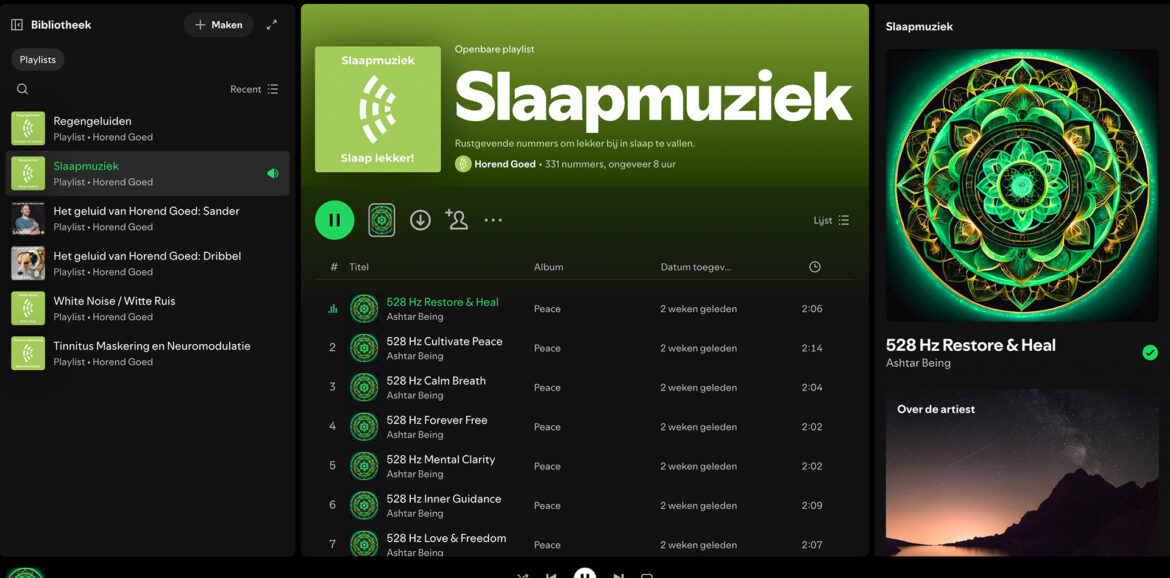Sometimes you lie in bed, eyes closed, but your head is still spinning overtime. You’ve turned off the lights, put the phone away, maybe even finished a cup of chamomile tea – and still it doesn’t work. The
The playlist is one long breath of calm: no beats, no vocals, no distractions. Just soft, undulating sounds that slowly rock you to sleep. Ideal for people who have trouble relaxing or can’t just “turn off” their heads.
Why music helps with sleep
Quiet music literally affects your body. When you listen to slow, flowing sounds, your heart rate slows down. Your breathing calms down, your muscles relax. Your brain switches from an active, alert state to a more dreamy state.
The tempo of this sleep music is low, around 50 to 70 beats per minute – similar to a relaxed heartbeat. That’s exactly why it works so well: your body automatically attunes to that rhythm. Within 15 minutes, you feel the tension slip away.
The magic of 528 Hz
The frequency of 528 Hz was not chosen at random. It is a tone that is naturally perceived as pleasant and harmonious. In sound therapy, this frequency is often used to
Bottom line: 528 Hz has a calming effect on the brain. The tone is right in the middle of our audible spectrum, making it feel natural and comfortable. That makes it the perfect base for ambient sleep music.
Ambient music: tranquility in its purest form
All the songs in the playlist are ambient – meaning they have no obvious melody or rhythm, but consist of elongated sounds, gentle sound waves and subtle changes in tone.
The idea is not that you actively “listen” to the music, but that you feel it. Ambient music fills the space without standing out. It forms a soft background that helps to let go of thoughts.
Some songs sound like a distant gust of wind, others like a warm glow or ripple-free sea. No sudden spikes, no harsh tones – just peace, concentration and stillness in sound.
Not all white noise is the same
Many people use white noise to sleep, but not every noise sounds the same. There is white noise (sharp and high), pink noise (softer and slightly fuller), and brown noise (low and deep). Ambient music at 528 Hz is right in between: warm, balanced and pleasant to hear for a long time.
This is important, because if the sound is too sharp or too low, it can actually make it restless. This playlist offers the best of both worlds – a consistent tone that provides calm, but does not become dull.
How the playlist is structured
The order of the playlist is deliberately chosen. The first tracks help you relax: soft tones, a bit of depth, a sense of space. After a few tracks, you notice that your thoughts become calmer. Then the music takes over from you – one long wave of calm frequencies, over eight hours long.
There are subtle transitions in it, so that nowhere do you wake up to a new song. Everything flows into each other. And if you want, you can put the playlist on a loop so it plays all night long.
Perfect for people who wake up at night and don’t want to lie around brooding again.
Why 528 Hz works better than random rest music
Many “relaxation playlists” on the Internet consist of all kinds of different frequencies and styles. Not bad in itself, but your brain has to adapt to new tones each time. The 528 Hz playlist remains stable. That constancy makes for deep relaxation, as if your brain is finally getting on the same wavelength.
Think of a rhythmic breathing pattern: in, out, in, out. Once it is regular, your body naturally settles down. This is also how this music works – no surprises, only harmony.
The science behind listening and sleeping
Music affects your brain waves. As soon as you listen to soothing sounds, your brain activity drops from the active beta range to the calmer alpha range. A little deeper still and you end up in theta waves – which is the dreamy phase between waking and sleeping.
During that process, your body produces melatonin, the sleep hormone. So music literally helps to flip the biological switch from active to rest.
Combine that with a few simple habits:
- Listen with soft earbuds or sleep headphones.
- Turn off your screens half an hour before sleeping.
- Breathe calmly and try not to think too much.
- Just let the music do its job.
8 hours of rest in frequency
The playlist lasts over eight hours – just enough for a full night. From falling asleep to waking up, without distracting interruptions or abrupt transitions.
People who suffer from tinnitus often find that the soft, constant tone masks the tinnitus. And because it is all ambient music, it remains pleasant even if you listen to it all night.
Who is this playlist for?
For anyone who wants to sleep better, but especially for people who:
- often lie awake due to stress or thoughts,
- suffer from tinnitus or hypersensitivity to sound,
- have difficulty falling asleep,
- Or simply looking for peace and quiet.
Children also respond well to it – the constant tone feels safe and predictable.
Our sleep music playlist on Spotify
You can find our sleep music playlist here.
Sleep well, at 528 Hz
The strength of this playlist lies in its simplicity: no lyrics, no beats, no stimuli. Just pure tranquility in sound.
So: put your phone away, pull the covers over you, press play, and let the ambient sounds of 528 Hz take you to a world without haste.
Sleep is not a struggle. Sometimes it’s just a matter of finding the right frequency.
And you have those now.








